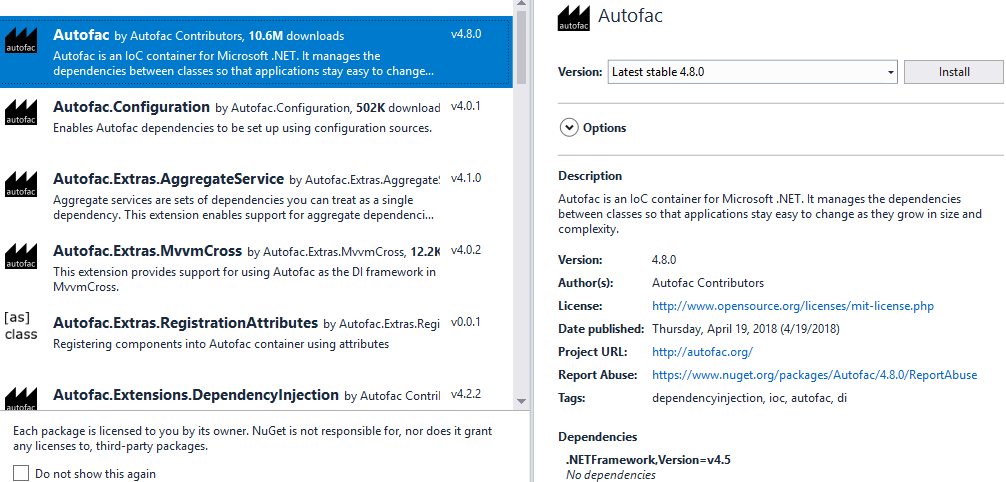Introduction
Workflow
-
add autofac package via nuget
-
create an IOC container
var builder = new ContainerBuilder(); var container = builder.Build(); -
register components
builder.RegisterType<ConcretClass1>().As<Interface1>().AsSelf(); builder.RegisterType<ConcretClass2>().As<Interface2>().AsSelf(); ...Please note that Autofac will automatically create an instance for us. If we hope to create a customized instance and inject. This feature is very useful for testing. e.g. we manually inject an instance.
var class1Instance = new ConcretClass1(); // set property values of this instance... builder.RegisterInstance(class1Instance).As<Interface1>(); -
get component instanced from container
var instance1 = container.Resolve<Interface1>(); var instance2 = container.Resolve<Interface2>();
Console demo
-
Install autofac package

-
Create services
order.cs
public class Order { public string orderId { get; set; } public DateTime createdTime { get; set; } public double totalAmount { get; set; } }order service interface
public interface IOrderService { void GrabNewOrders(int days); void ShipOrder(Order order); }order service
public class OrderService : IOrderService { public void GrabNewOrders(int days) { System.Console.WriteLine("Grabbed 100 new orders within " + days + " days"); System.Console.WriteLine("Saved 100 new orders within " + days + " days"); } public void ShipOrder(Order order) { System.Console.WriteLine(string.Format("ship order id: {0}, amount: {1}", order.orderId, order.totalAmount)); } } -
Use autofac to builder the IOC container and register service, then resolve
// create ioc container builder var builder = new ContainerBuilder(); // register service builder.RegisterType<OrderService>().As<IOrderService>().AsSelf(); // generate container var container = builder.Build(); // resolve service using (var scope = container.BeginLifetimeScope()) { var orderService = scope.Resolve<IOrderService>(); orderService.GrabNewOrders(10); orderService.ShipOrder(new Order(){orderId = "#001", totalAmount = 100, createdTime = DateTime.Now}); } -
result

Webapi demo
-
create a .net 4.6 webapi project
-
nuget > install
AutofacAutofac.integration.WebAPI
-
create App_Start\AutofacWebapiConfig
using Autofac; using Autofac.Integration.WebApi; using System; using System.Collections.Generic; using System.Linq; using System.Reflection; using System.Web; using System.Web.Http; namespace Tweebaa.Api.App_Start { public class AutofacWebapiConfig { public static IContainer Container; public static void Initialize(HttpConfiguration config) { Initialize(config, RegisterServices(new ContainerBuilder())); } public static void Initialize(HttpConfiguration config, IContainer container) { config.DependencyResolver = new AutofacWebApiDependencyResolver(container); } private static IContainer RegisterServices(ContainerBuilder builder) { //Register your Web API controllers. builder.RegisterApiControllers(Assembly.GetExecutingAssembly()); //Register components builder.RegisterType<ConcretClass1>() .As<Interface1>() .AsSelf() .InstancePerRequest(); //Set the dependency resolver to be Autofac. Container = builder.Build(); return Container; } } } -
global.asax
public class WebApiApplication : System.Web.HttpApplication { protected void Application_Start() { GlobalConfiguration.Configure(WebApiConfig.Register); //Configure AutoFac AutofacWebapiConfig.Initialize(GlobalConfiguration.Configuration); } } -
In each controller, service, dao class, modify the contrustor to declare all arguments. These declared arguments will be identified by autofac and injected instances automatically.
public class BaseController : ApiController { protected Interface1 instance1; protected Interface2 instance2; public BaseController(Interface2 instance1 , Interface2 instance2) { this.instance1 = instance1; this.instance2 = instance2; } ... }
FAQ
-
what is the default constructor where there are multiple constructors.
the constructor with the most arguments
-
How to explicitly choose a constructor when Autofac build a contrainer?
-
method1 - by typeof parameter:
builder.RegisterType<ConcretClass>() .UsingConstructor(typeof(Parameter1Type), typeof(Parameter2Type)); -
method2 - by IComponentContext lambda expression argument match
builder.Register(c => new Engine(c.Resolve<Parameter1Type>(), c.Resolve<Parameter2Type>());
-
References
http://www.c-sharpcorner.com/article/using-autofac-with-web-api/